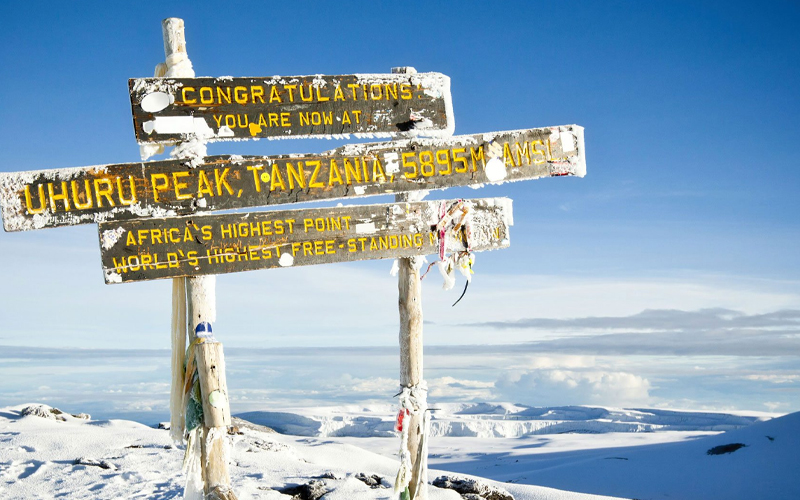What to Expect at the Top
Climbing Mount Kilimanjaro is a bucket-list adventure for many, but the journey to Uhuru Peak (19,341 feet/5,895 meters) isn’t just about physical endurance—it’s also about braving extreme weather conditions. As you ascend through Kilimanjaro’s five distinct climate zones, you’ll encounter everything from tropical heat to arctic cold. Understanding and preparing for the summit’s weather conditions can make or break your climb.
This guide will take you through what to expect at the top of Kilimanjaro, including temperature ranges, wind speeds, and other environmental factors. By knowing how to gear up for the summit, you can stay safe and comfortable as you take on Africa’s highest peak.
Kilimanjaro’s Climate Zones
Kilimanjaro’s landscape is unique, as the mountain features five different climate zones, each with its own weather patterns. As you ascend, you’ll notice the gradual change from tropical conditions at the base to freezing temperatures near the summit. The five climate zones are:
- Cultivation Zone (2,600 to 6,000 feet/800 to 1,800 meters): Warm and humid, with cultivated farmland.
- Rainforest Zone (6,000 to 9,200 feet/1,800 to 2,800 meters): Hot, humid, and often misty with lush vegetation and heavy rains.
- Heather-Moorland Zone (9,200 to 13,200 feet/2,800 to 4,000 meters): Cooler, with short shrubs and alpine plants.
- Alpine Desert Zone (13,200 to 16,500 feet/4,000 to 5,000 meters): Harsh and dry, with significant temperature variations between day and night.
- Arctic Zone (16,500+ feet/5,000+ meters): The summit zone, where temperatures drop below freezing and oxygen levels are dangerously low.
At the summit, you’ll be facing extreme cold, with temperatures that can dip well below freezing, coupled with strong winds and thin air.
Summit Temperatures: How Cold Does It Get?
Once you reach the Arctic Zone, the weather conditions are drastically different from the lower altitudes. At the summit, temperatures can drop to as low as -20°C (-4°F) at night or during the early morning, when most summit attempts are made.
Typical Temperature Ranges at the Summit:
- Daytime: -5°C to 5°C (23°F to 41°F)
- Nighttime: -20°C to -10°C (-4°F to 14°F)
Keep in mind that while daytime temperatures at the summit can be slightly warmer when the sun is out, the high-altitude winds and lack of oxygen make it feel much colder. Additionally, the drastic temperature drop from day to night means you’ll need to be prepared for extreme cold during summit night.
Wind Conditions at the Summit
Wind can make an already cold summit experience feel even more brutal. On average, wind speeds at the summit range from 20 to 40 km/h (12 to 25 mph), but gusts can be even stronger during certain times of the year. The combination of cold temperatures and high winds can lead to a phenomenon known as wind chill, which makes the air feel significantly colder than the actual temperature.
- Wind Chill: With strong winds, the perceived temperature can drop by several degrees. For example, at a temperature of -10°C (14°F), a wind of 20 km/h (12 mph) can make it feel closer to -20°C (-4°F).
- Summit Night Winds: The early hours of the morning (around 1:00-6:00 AM), when most climbers attempt the final ascent, often have the strongest winds.
Pro Tip: Wearing windproof layers is essential to avoid losing body heat during these windy conditions.
Effects of Altitude on Weather
The weather at high altitudes is notoriously unpredictable. As you climb higher on Kilimanjaro, the atmospheric pressure decreases, causing a drop in both temperature and oxygen levels. Here’s how altitude affects the weather at the summit:
- Lower Oxygen Levels: The air becomes thinner the higher you go, making it harder for your body to regulate temperature. You’ll feel colder more easily and be more susceptible to altitude sickness.
- Sudden Weather Shifts: Clear skies can quickly turn into snow flurries or gusting winds, especially at high altitudes. It’s not uncommon for climbers to experience light snow or hail even during the dry season.
- Altitude Sickness: Symptoms like headaches, dizziness, and nausea are common as you ascend to higher altitudes. Altitude sickness can also affect your body’s ability to stay warm, which is why acclimatization is key.
Best Time to Reach the Summit
While Kilimanjaro can be climbed year-round, weather conditions are generally more favorable during certain months. The best times to summit Kilimanjaro, with the most stable weather, are during the dry seasons:
- January to March: These months are slightly colder but quieter in terms of crowds. You may experience snow at the summit, especially in February.
- June to October: These months are considered the best for summit attempts, with warmer temperatures, less rain, and clearer skies. However, this is also the busiest time for trekking.
Avoid climbing Kilimanjaro during the rainy seasons (April-May and November-December), as trails can be slippery, and visibility may be reduced due to fog and clouds.
Tips for Staying Warm and Safe
Given the extreme weather conditions at the summit, staying warm and safe should be your top priority. Here are some essential tips:
Dress in Layers
Layering is crucial to regulate your body temperature effectively. The basic system includes:
- Base Layer: Moisture-wicking thermals to keep sweat off your skin.
- Insulating Layer: Fleece or down to retain heat.
- Outer Layer: Windproof and waterproof shell to protect against the elements.
Keep Your Extremities Warm
Your hands, feet, and face are particularly vulnerable to the cold.
- Wear Thermal Gloves: Opt for a glove liner combined with insulated outer gloves.
- Use Thermal Socks: Wool or thermal socks are a must for keeping your feet warm, especially on summit night.
- Protect Your Face: A buff or balaclava can help shield your face from the icy wind.
Hydrate Frequently
At high altitudes, dehydration is common and can make you feel even colder. Drink water regularly, even if you don’t feel thirsty.
Take Breaks to Refuel
You’ll be burning more calories at high altitudes, so keep snacks like energy bars or trail mix on hand for quick energy boosts during the climb.
What to Pack for Summit Night
Summit night is the most challenging part of the Kilimanjaro trek, where temperatures are at their lowest and conditions can be harsh. Here’s what you need to pack:
- Insulated Down Jacket: A high-quality down jacket is essential for keeping your core warm.
- Fleece or Down Pants: Layered over your thermal base layers to protect your legs from the cold.
- Windproof Gloves: Insulated gloves with an additional waterproof layer.
- Thermal Hat: A warm beanie or hat to protect your head and ears.
- Headlamp with Extra Batteries: You’ll start your summit attempt in the dark, so a bright headlamp is a must.
- Hand and Foot Warmers: Disposable warmers can be lifesavers when temperatures plummet.
- Water in Insulated Bottles: Make sure your water bottles are insulated to prevent them from freezing.
- Sunglasses: You’ll need these to protect your eyes from the glare of the sun reflecting off the snow when the sun rises at the summit.
Prepare for the Challenge
The summit of Mount Kilimanjaro offers some of the most stunning views in the world, but it also presents extreme weather conditions. By understanding what to expect and packing the right gear, you can increase your chances of a successful, safe, and enjoyable summit.
Climbing Kilimanjaro is a life-changing adventure, but preparation is key. Dress warmly, protect yourself from the wind, and keep your body fueled to enjoy every moment as you ascend to the roof of Africa!
For more details, please visit our pages:

